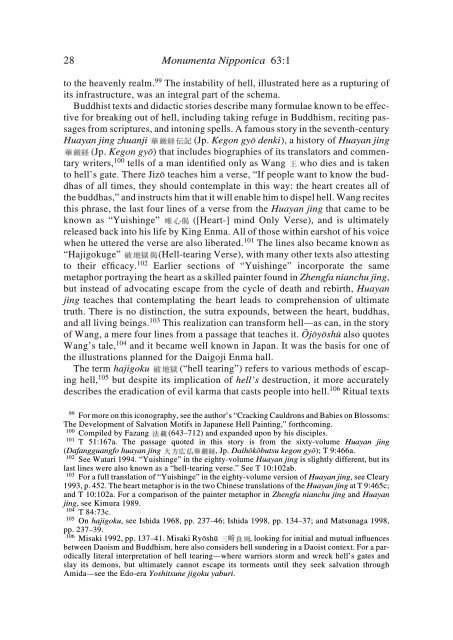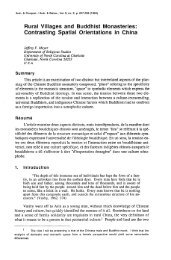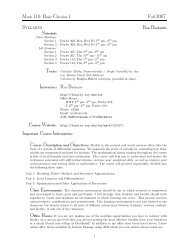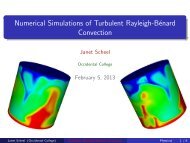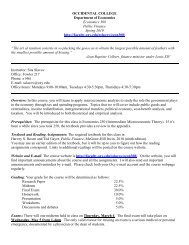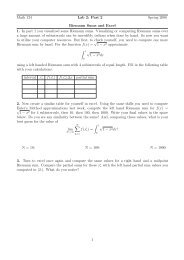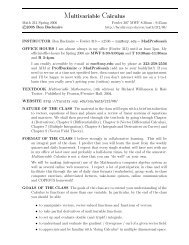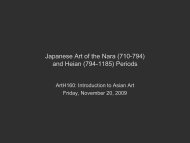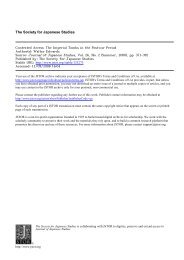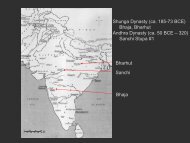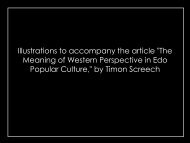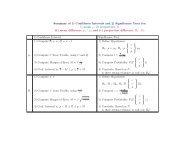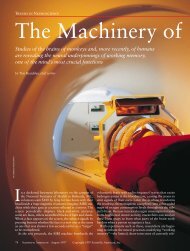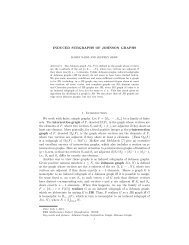A Primer on Japanese Hell Imagery and Imagination - Occidental ...
A Primer on Japanese Hell Imagery and Imagination - Occidental ...
A Primer on Japanese Hell Imagery and Imagination - Occidental ...
Create successful ePaper yourself
Turn your PDF publications into a flip-book with our unique Google optimized e-Paper software.
28<br />
M<strong>on</strong>umenta Nipp<strong>on</strong>ica 63:1<br />
to the heavenly realm. 99 The instability of hell, illustrated here as a rupturing of<br />
its infrastructure, was an integral part of the schema.<br />
Buddhist texts <strong>and</strong> didactic stories describe many formulae known to be effective<br />
for breaking out of hell, including taking refuge in Buddhism, reciting passages<br />
from scriptures, <strong>and</strong> int<strong>on</strong>ing spells. A famous story in the seventh-century<br />
Huayan jing zhuanji (Jp. Keg<strong>on</strong> gyô denki), a history of Huayan jing<br />
(Jp. Keg<strong>on</strong> gyô) that includes biographies of its translators <strong>and</strong> commentary<br />
writers, 100 tells of a man identified <strong>on</strong>ly as Wang who dies <strong>and</strong> is taken<br />
to hell’s gate. There Jizô teaches him a verse, “If people want to know the buddhas<br />
of all times, they should c<strong>on</strong>template in this way: the heart creates all of<br />
the buddhas,” <strong>and</strong> instructs him that it will enable him to dispel hell. Wang recites<br />
this phrase, the last four lines of a verse from the Huayan jing that came to be<br />
known as “Yuishinge” ([Heart-] mind Only Verse), <strong>and</strong> is ultimately<br />
released back into his life by King Enma. All of those within earshot of his voice<br />
when he uttered the verse are also liberated. 101 The lines also became known as<br />
“Hajigokuge” (<strong>Hell</strong>-tearing Verse), with many other texts also attesting<br />
to their efficacy. 102 Earlier secti<strong>on</strong>s of “Yuishinge” incorporate the same<br />
metaphor portraying the heart as a skilled painter found in Zhengfa nianchu jing,<br />
but instead of advocating escape from the cycle of death <strong>and</strong> rebirth, Huayan<br />
jing teaches that c<strong>on</strong>templating the heart leads to comprehensi<strong>on</strong> of ultimate<br />
truth. There is no distincti<strong>on</strong>, the sutra expounds, between the heart, buddhas,<br />
<strong>and</strong> all living beings. 103 This realizati<strong>on</strong> can transform hell—as can, in the story<br />
of Wang, a mere four lines from a passage that teaches it. Ôjôyôshû also quotes<br />
Wang’s tale, 104 <strong>and</strong> it became well known in Japan. It was the basis for <strong>on</strong>e of<br />
the illustrati<strong>on</strong>s planned for the Daigoji Enma hall.<br />
The term hajigoku (“hell tearing”) refers to various methods of escaping<br />
hell, 105 but despite its implicati<strong>on</strong> of hell’s destructi<strong>on</strong>, it more accurately<br />
describes the eradicati<strong>on</strong> of evil karma that casts people into hell. 106 Ritual texts<br />
99 For more <strong>on</strong> this ic<strong>on</strong>ography, see the author’s “Cracking Cauldr<strong>on</strong>s <strong>and</strong> Babies <strong>on</strong> Blossoms:<br />
The Development of Salvati<strong>on</strong> Motifs in <strong>Japanese</strong> <strong>Hell</strong> Painting,” forthcoming.<br />
100 Compiled by Fazang (643–712) <strong>and</strong> exp<strong>and</strong>ed up<strong>on</strong> by his disciples.<br />
101 T 51:167a. The passage quoted in this story is from the sixty-volume Huayan jing<br />
(Dafangguangfo huayan jing<br />
, Jp. Daihôkôbutsu keg<strong>on</strong> gyô); T 9:466a.<br />
102 See Watari 1994. “Yuishinge” in the eighty-volume Huayan jing is slightly different, but its<br />
last lines were also known as a “hell-tearing verse.” See T 10:102ab.<br />
103 For a full translati<strong>on</strong> of “Yuishinge” in the eighty-volume versi<strong>on</strong> of Huayan jing, see Cleary<br />
1993, p. 452. The heart metaphor is in the two Chinese translati<strong>on</strong>s of the Huayan jing at T 9:465c;<br />
<strong>and</strong> T 10:102a. For a comparis<strong>on</strong> of the painter metaphor in Zhengfa nianchu jing <strong>and</strong> Huayan<br />
jing, see Kimura 1989.<br />
104 T 84:73c.<br />
105 On hajigoku, see Ishida 1968, pp. 237–46; Ishida 1998, pp. 134–37; <strong>and</strong> Matsunaga 1998,<br />
pp. 237–39.<br />
106 Misaki 1992, pp. 137–41. Misaki Ryôshû h , looking for initial <strong>and</strong> mutual influences<br />
between Daoism <strong>and</strong> Buddhism, here also c<strong>on</strong>siders hell sundering in a Daoist c<strong>on</strong>text. For a parodically<br />
literal interpretati<strong>on</strong> of hell tearing—where warriors storm <strong>and</strong> wreck hell’s gates <strong>and</strong><br />
slay its dem<strong>on</strong>s, but ultimately cannot escape its torments until they seek salvati<strong>on</strong> through<br />
Amida—see the Edo-era Yoshitsune jigoku yaburi.


